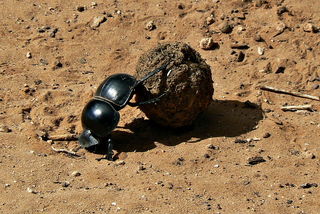Evolutionary Psychology
The Making of Disgust
Instincts, instructions—and insects
Posted June 2, 2016

We aren’t born disgusted. Babies show no signs of disgust. They exhibit distaste, but this is a purely sensory (not emotional) response. Researchers found that nearly two-thirds of diapered subjects ate imitation dog feces crafted from peanut butter and stinky cheese. However, only one-third ate a whole, sterilized grasshopper. Go figure.
A capacity for disgust develops between the ages of 4 and 8, then increases with sexual maturation. Adolescents are highly responsive to repulsive stimuli, but disgust sensitivity declines into adulthood.
We acquire disgust through direct experience, observational modeling, communication of negative information—and associative learning. People reject an otherwise appealing drink if they’ve seen a cockroach in a different glass of the same liquid. Even when assured that the dunked cockroach is sterilized, they still reject the beverage.
If disgust is so entrenched in the human psyche, could our revulsion toward insects be rooted in evolution? The evidence that we are genetically predisposed to wrinkle our noses at maggots and cockroaches is intriguing.
To begin, the facial contortions that we recognize as expressing disgust are shared across the world. And some stimuli elicit disgust across cultures. People from Burkina Faso, Hong Kong, India, Japan, Korea, The Netherlands, the United Kingdom, and the United States are all repulsed by the ‘standards’ (e.g., flies, cockroaches and spiders).
Natural selection has shaped disgust to inhibit our contact with infectious or intoxicating substances. Evolutionary psychologists contend that prepared learning explains our tendency to associate certain animals with disgust. Stinky, greasy, wriggling creatures have been particularly likely to transmit disease throughout human history, so we are primed to find cockroaches and maggots gross.
But of course, the cultural constructivists aren’t about to cede disgust to the evolutionary biologists. Anthropologists have documented a staggering array of animals, plants, and fungi that humans eat, and such diversity is taken as evidence that our disgust toward certain foods is a cultural artifact. Why should eating a grasshopper be any more repulsive than drinking the milk of another species?
What about feces—isn’t the universal disgust toward this substance evidence that evolution calls the shots? Not so fast. A study of feral humans revealed that without social interaction humans find fecal odors interesting and not repulsive.
In the name of tolerance, western culture inculcates a kind of politically correct appreciation of nature. Instead of judging organisms on our terms, we’re supposed to accept them for what they are. However, when a humongous grasshopper regurgitates and defecates (perhaps I should say, “pukes and craps” to retain an earthy integrity) no amount of cultivated sensitivity saves this from being a disgusting encounter.
In the end, we are left with two stories about the making of disgust: evolution and culture. The resolution is simple—both nature and nurture matter. Insects infest our minds because we are culturally malleable creatures operating within evolutionary constraints—and the thought of eating a grasshopper lies somewhere between raw oysters and kimchi.


